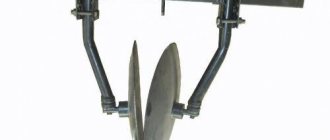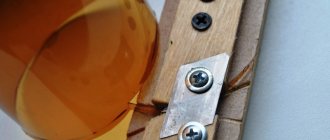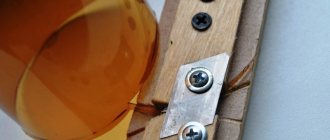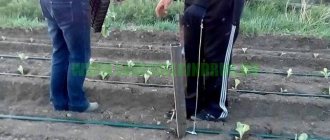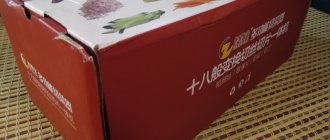Vegetable growing » Potatoes
0
1555
Article rating
Kira Stoletova
Potato tubers come in different sizes. Their sorting provides the root crop with greater shelf life. Non-mechanized potato sorting takes a lot of time and effort. Let's look at devices for sorting potatoes that make this process as fast and simple as possible.
Devices for sorting potatoes
Lattice table
When working with small volumes of crops, it is not necessary to hire special equipment or make complex structures. The most successful sorting of small quantities of potatoes is ensured by a grid table. A special drawer serves as a tabletop for it. The design is based on the passage of potatoes of the required size through a special grid, the beams of which diverge: thereby, small tubers fall before large ones.
Under the countertop there are several drawers into which the sorted root vegetables will go. A tuber of the required size falls into each tray. The table should be slightly tilted so that the potatoes themselves roll down the racks and end up in the right place.
A potato sorting table will become a convenient assistant in the household, but it has two drawbacks:
The size of the wooden box is recommended to be 1500x800x25mm. The gaps between the yards should be approximately 35 cm at the beginning and 60 cm at the end of the table.
Method 1. Potato greening
nutricionistarafael.com.br
In the light, chlorophyll is formed in potato tubers and a toxic substance, solanine, accumulates, which is dangerous not only for humans (if a large dose of the substance is consumed), but also for various fungi and bacteria. In addition, “green” potatoes are more durable and are not afraid of rodent invasion. Therefore, you can prepare seed tubers in this way in the fall, after harvesting. But it’s not too late to do this in the spring before the germination procedure.
Place whole, undeformed tubers in a single layer in a room at room temperature with indirect light. Turn the potatoes every 3-4 days to ensure they turn green evenly. After 10-15 days, when the tubers become rich green, the procedure can be completed.
Result: the peel is cleared of dangerous fungi and bacteria, the tubers are protected from rodent attacks. Shoots appear quickly and ahead of schedule.
Cylindrical potato sorting
This version of a homemade sorting station is a little more complicated than the previous one. It includes: two rod cylinders soldered together, a hopper, pitched gratings, a manual drive and a frame. Grids with holes of different diameters are placed inside the cylinders.
When the cylindrical machine operates, the potatoes are sorted into three parts: small, medium and large. The first two parts are sorted sequentially in the cylinders, and the large potatoes come out. Various debris is filtered out using additional grids. The dimensions of the frame depend accordingly on the size of the cylinders.
Mobile potato sorting L-701
Mobile potato sorting L-701 is a large unit that packs root crops into three parts, just like the previous design. Only such a machine is designed to work on large agricultural fields. It is capable of working both autonomously and in conjunction with a tractor in the field.
The design of such a potato sorter consists of flat, rubber-coated gratings. The holes in them are square with sides of 35 and 50 cm. The unit has its own electric drive with a power of 1.5 kW. Under favorable conditions, the machine is capable of processing 5 tons of potatoes per hour.
Unlike self-designed sorting mechanisms, the L-701 unit has quite large dimensions:
Method 3. Sprouting potatoes
It is advisable to germinate potatoes before planting. This procedure awakens the kidneys and reduces the effects of late blight. There are several methods of germination. Choose the one that will be easier and more convenient for you to implement.
Dry germination
Place the potatoes in 1-2 layers on pallets, in boxes or simply on the floor. Choose a bright and warm room (18-20°C). After 10 days, lower the temperature to 10-14°C. Remember to turn the tubers over so they are evenly illuminated. After about 20-30 days, the potatoes will be covered with sprouts up to 2 cm long.
To save space, you can not lay out the potatoes on the surface, but place 15-20 pieces in nets or transparent plastic bags and hang them in a well-lit place. If you use bags, first make holes in them for air exchange.
Germination in a humid environment
Place the selected tubers in a container with a damp substrate: peat, sawdust, humus or sphagnum moss. Potatoes should be kept in a dark room at a temperature of 12-15°C. Keep the substrate moist constantly for two weeks.
This method allows you to obtain juicy tubers with many strong sprouts and roots.
Combined germination
Sprout the potatoes using the dry method for 20-25 days, and then place them in the moist substrate described above for 10 days.
Drying
One of the fastest methods of germination. Spread the seed potatoes in a single layer on the floor or in boxes. The room should be bright, with a temperature of about 20°C. After 1-1.5 weeks, the tubers will wrinkle and become covered with sprouts.
Warming up
This method will help out when there is catastrophically little time to prepare tubers for planting. Place the potatoes in a room with a temperature of 12-15°C. After 4-6 hours, increase the temperature by two degrees. Subsequently, increase it by this value every 2 hours, but make sure that the readings do not exceed 22°C. But it is not recommended to immediately transfer potatoes from cold to warm, because... this will worsen the taste of the tubers of the future harvest.
Result: seedlings appear 1.5-2 weeks ahead of schedule and gain green mass faster.
During the germination process, weak and diseased tubers can be discarded, and the rest can be treated with drugs against diseases and pests, and growth stimulants.
Sorter M 616
The M 616 sorter is a large unit that sorts potatoes into 4 parts. Its design allows the machine to be moved by one person.
Potatoes are sorted as follows:
The design of potato sorting includes the following elements: feeding conveyor, heated selection table, conveyor, bag filler. The support of the machine is a frame standing on rubber wheels. Approximate amount of work per hour: 5 tons of potatoes.
Source
DIY potato sorter
The harvested potato crop is sorted before being stored for winter storage, and shortly before spring planting - small tubers are separated, which are fed to livestock or processed into starch. The potato sorter shown in Figure 1 allows you to mechanize this work. It consists of the following main parts: two paired rod cylinders, a loading hopper, pitched rod grids for various potato fractions, a manual drive and a frame. The base of each cylinder is made of wooden hoops with crosspieces. The hoops consist of individual elements connected to each other and to a cross with spikes and steel spacers.
How to make potato sorting yourself
Authorization on the site
It consists of the following main parts: two paired rod cylinders, a loading hopper, pitched rod screens for various potato fractions, a manual drive and a frame. The base of each cylinder is made of wooden hoops with crosspieces. The hoops consist of individual elements connected to each other and to a cross with spikes and steel spacers.
To prevent mechanical damage to potatoes during sorting, the crosspieces are made of a round shape.
Wooden rods with a diameter of 15–16 mm and a length of 650–700 mm are attached to the inside of the hoops. They are made of durable wood and attached to the hoops using flexible metal tape and screws. Recesses are made in the hoops for storing the rods.
The distance between the cylinder rods for small fraction potatoes is approximately 30.35 mm, and for medium - 40.50 mm. Inner diameter of at least 700 mm.
Rice. 1. Potato sorter: 1 - wooden frame; 2 - pitched board for coarse potatoes; 3 — cylinder shaft; 4 - manual gate; 5 - bearing; 6 - rod cylinder of medium-fraction potatoes; 7 — rod cylinder of fine-grained potatoes; 8 — loading hopper; 9 - pitched lattice of fine-grained potatoes; 10 - pitched lattice of medium-fraction potatoes; 11 - wooden hoop; 12 - wooden rod; 13 — cross; 14 — hoop element; 15 — steel plate; 16 — cross-shaped pad; 17 — hub with a locking bolt. The cylinders are connected with bolts. Depending on the size of the cylinders, the appropriate frame dimensions are selected. The frame can be made of wooden blocks with a section of 60x60 mm or angle steel 35x35x4 mm. During operation, the cylinders are set at an angle of 8.10°. Potato sorting divides the tubers into three fractions: small, medium and large. Small and medium potatoes are sequentially sifted through the first and second rod cylinders, and large ones are sent to the exit. The earth and small impurities are separated through the sloping grates.
Potatoes as a raw material for food production
Requirements for the main quality indicators of potatoes upon acceptance at the enterprise must comply with current standards, taking into account the intended purpose.
Potatoes supplied for processing must have high technological advantages and have good preservation over a long period of storage.
The basic requirements for potatoes as a raw material for the production of potato products can be formulated as follows.
1. Tubers should have a high content of dry matter and starch, since the yield of products and their fat-absorbing ability depend on this. It is advisable to use potatoes containing at least 23% dry matter.
2. Varieties with non-darkening pulp are required; for this they should contain no more than 0.2-0.4% of reducing sugars (from wet weight).
3. Tubers must be smooth, regular in shape, with a minimum number and shallow eyes. Processing of such raw materials makes it possible to improve washing, reduce labor costs and waste for cleaning and post-cleaning potatoes. The peel should be thin and smooth, which reduces losses and increases production yield, but dense enough to protect the tubers from adverse external influences.
4. Potatoes must have good taste and boilability.
5. Promising varieties have good keeping quality, a slight tendency to accumulate sugars, good resynthesizing ability, and are resistant to diseases and damage.
6. It is not allowed to use frozen tubers or those affected by agricultural pests and diseases for the production of all types of potato products.
Only by using raw materials that meet industrial requirements can high-quality products with good technical and economic indicators be produced. In order to reduce the cost of potato products and obtain raw materials that meet the requirements of the industry, it is necessary to carry out commercial processing at the potato production sites and at the enterprise. It allows you to obtain products of uniform quality with the same consumer properties.
Commodity processing - sorting, sizing and packing into containers - can be carried out either with the help of separate transport devices, or with the use of potato sorting units, stationary and mobile. Schemes of the mechanized production line and sorting point are shown in Fig. 3 and 4.
Rice. 3. Diagram of a mechanized production line for commercial processing of potatoes: 1 - container tipper; 2 - bunker; 3 — roller conveyor; 4 - sorting; 5 — lock hopper; 6 — rod conveyor; 7 - sink; 8 — line for preliminary drying of tubers; 9 — conveyor; 10 — heater; 11 - dryer; 12 — roller bulkhead machine; 13 — conveyor-dispenser; 14 - scales.
Rice. 4. Sorting point KSP-20: 1 - movable bottom of the bunker; 2 — loading conveyor; 3 — separating conveyor; 4 - sorting surface; 5, 6, 7 — remote conveyors; 8, 9, 10 - container.
The sorting point allows you to select three fractions of tubers of different sizes in a batch of potatoes, separate soil and mechanical impurities, and sort tubers of non-standard quality. To sort potatoes that are sensitive to damage (immature, with uncorked skin), it is advisable to use rubber-coated sieves.
There are sorting devices that allow you to calibrate potatoes into a larger number of fractions. For example, in Germany they use sorting machines with flat sieves and boxes located one below the other, designed for calibration for six fractions. Machine productivity is 30 t/h.
Dividing a batch of potatoes into fractions at the receiving site of the enterprise allows tubers of different sizes to be sent in accordance with their intended purpose for the production of fried, frozen or dried potato products, and non-standard tubers to be used for the preparation of starch.
Back
DIY potato sorter
Before storing potatoes for the winter, they must be sorted and sorted. If there are a lot of tubers, the process can be mechanized: assemble a potato sorter yourself.
The device consists of several parts. These are 2 paired cylinders made of rods, a loading hopper, rolling rods, a manual drive and a frame.
Wooden rods with a diameter of 16 mm and a length of 700 mm are attached to the hoops from the inside. They are attached to the hoops using a flexible metal tape, after which they are tightened with screws. To lay the rods in these hoops you need to make small recesses.
The cylinders are connected with bolts. The sizes of the cylinders are different, which means that corresponding frames are needed. They are made from wooden blocks with a cross-section of 60×60 mm. You can use 35x35 mm angle steel instead, with a metal thickness of about 4 mm. The cylinders must be installed at an angle of 8-10°.
The sorter works this way. Small and medium potatoes are sifted through the first and second rod cylinders. Large tubers are immediately released. Of course, various debris remains from the potatoes (small fractions of soil, various impurities), but it comes out through the sloping grates.
Features of the root crop sorter and method
The mesh is here for filling the potatoes from the refrigerator. Hoops from an old washing machine. Trimmed 4 cm in width. Made 3 hoops. The axle is a 15mm pipe. I drilled holes and inserted rods from wire sixes. Got it with welding. There are no bearings here. Mesh size: square 50 x 50, chain-link 35x35, maybe 40 x 40. This depends on the size of your potatoes. Root vegetables are filtered into three fractions. It immediately pours out through the fine mesh. Then the seed. At the end the largest one flies out. Potatoes, passing through a 50 x 50 mesh, can be partly left for seeds, partly for food. The amount of work that was previously done manually without mechanization for several days can be completed in a few hours with the help of this sorting device.
The device is simple, made in haste. There are no complex mechanical components here. But the potatoes are sorted wonderfully. The fruits do not break. Size distribution occurs as needed.
Another option
When sorting potatoes by hand, when you sit and sort through them in the barn, you start throwing small ones, large ones and vice versa. The work is routine and quite boring. So isn’t it better to use the experience of craftsmen to make this work easier and make it an interesting event?
Why are potatoes sorted, sorting parameters
Before harvesting potatoes for the winter, they must be sorted by size, variety, appearance and other indicators important to producers or households.
Enterprises sort tubers according to the following scheme: 4-6 cm; 6-8 cm; over 8 cm. Potatoes that do not fall into even the smallest classification are collected separately.
Small potatoes from the first two groups are sent to store shelves, and larger ones are sent to vegetable markets. The largest, most selected tubers are kept by the harvesters for seeds and also supplied to public catering outlets.
Important! Sick and damaged tubers are discarded, which will quickly begin to rot and ruin the entire harvest. Also, when sorting, any plants, lumps of earth, stones and other debris are removed.
What is potato caliber?
According to GOST 7176-2017 “Wood potatoes. Technical specifications" potato tubers are calibrated - that is, sorted by size.
What happens
The smallest caliber is less than 3. This means that the transverse diameter of the tuber is up to 30 mm. Such potatoes are called small; they are used as animal feed and used to produce starch.
Large caliber is designated 6+. Large tubers are in demand in the food industry.
What does caliber 4, 5, etc. mean?
Well-selling and sought-after potatoes have calibers of 4+, 5+, 6+.
The average size is 40 and 50 mm in diameter, respectively, these are tubers with caliber 4+ and 5+.
Large potatoes have a size of 60 mm or more, caliber - 6+.
The mechanism and its effectiveness
There are two ways to sort potatoes:
Mechanized sorting is suitable for large harvests and consists of separating small tubers from large ones using a large sieve.
Mechanized sorting is divided into manual and automatic. The first is suitable for home harvesting for the winter, since it is slower, but cheaper than the automated one. The second type of sorting is used with special equipment and the crop is processed in tons.
Method 4. Disinfection of potatoes
hr.gadeners.com
Potatoes often become infected with fungal and bacterial diseases, so the seed tubers need to be disinfected. This can be done before germination (see Method 3) or a few days before planting in the ground. Typically, summer residents use special preparations: Fitosporin-M, Fludioxonil, Pentsikuron, etc. Complex action products that protect both from diseases and pests are also popular: Prestige, Maxim, etc.
But you can get by with self-prepared medications. For example, spraying tubers with a 1% solution of Bordeaux mixture has a good effect. Also for disinfection, use copper sulfate (20 g) in combination with potassium permanganate (1 g) per bucket of water. First dilute the required amount of the substance in 1 liter of warm water, and then add water to 10 liters.
During spraying, it is important to thoroughly moisten all tubers with the selected solution. Effective protection is provided by soaking in aqueous solutions (25-30 minutes):
Effective protection is provided by soaking in aqueous solutions (25-30 minutes):
- boric acid (50 g per 10 l of water);
- potassium permanganate (1 g per 10 l);
- zinc sulfate (10 g per 10 l).
When using formaldehyde (30 g per 10 liters of water), the tubers are kept in solution for no more than 15 minutes.
Result: the tuber skin is cleared of pathogens, young plants have reliable immunity.
7 main problems with potatoes: diseases, their signs, prevention and means of control “Second bread” during storage or growing season begins to wither, darken or even rot? We will help you identify and treat a possible disease before it’s too late!
Lattice table
One of the simplest, but at the same time quite effective means for saving time on sorting potatoes is a lattice table.
In essence, it is an ordinary wooden box with a lattice bottom. These are found on grocery and vegetable counters and in food wholesale stores. You can buy them or ask them for free from store employees.
The box will have to be modified a little by narrowing the bottom slats on one side so that larger potatoes can slip through them. This can be done using a regular or circular saw or hacksaw.
Attention! If you don’t have the opportunity to find a ready-made box, you can make it yourself from scraps of boards and bars, plywood.
Materials with a thickness of 30-35 mm are suitable. The length of the tray is not less than 1500 mm, the width is 750 mm, the height of the sides is not less than 250 mm, otherwise the potatoes will spill out even before sorting.
Necessary materials
The basis of the body of our potato planter is a pipe. The diameter of the pipe is selected in such a way that the potato tuber can move inside it calmly and without getting stuck anywhere. As a rule, a pipe with a diameter of at least 70 mm is used.
DIY potato planter
The length of the pipe is selected individually and is usually 80-90 cm. It is advisable to use a thin-walled pipe. This is necessary in order not to make the entire device very heavy. At the same time, the pipe must be strong enough so as not to deform from frequent efforts to insert the device into the ground.
The valve is made of iron; its thickness should not be less than the thickness of the walls of the pipe itself. To attach the valve, we need a hinge, the role of which can be successfully performed by a regular door hinge. A durable metal sheet, or corner, is also used for the footrest.
You will also need a handle and an upper basket for tubers and a feed limiting mechanism. It can be easily made from a mesh or an unnecessary bucket. So, we find and prepare:
- A light but durable pipe with a diameter of at least 70 mm.
- Durable metal sheet for valve cover
- Valve joint
- Two metal handles (such as two half-inch pieces of water pipe)
- Mesh basket or bucket
Potato grading in cylinder shape
This type of device is more difficult to make, but still possible. It will speed up the work and the amount of sorted harvest significantly.
For this you will need:
To make potato sorting, you need to place grids with holes of different diameters inside the cylinders.
Potatoes are separated into 3 fractions: small, medium and large. Small and medium tubers are sorted sequentially, and large ones are rolled out. Any debris that accidentally gets into the potatoes is sifted out using additionally installed small grids.
Digging potatoes with a walk-behind tractor
To start harvesting potatoes, we take several bags, a pitchfork, a shovel and gloves to the garden. Digging potatoes with a walk-behind tractor makes work easier. Not everyone can use this tool, but it makes harvesting faster (if you get the hang of it). Harvesting potatoes with a walk-behind tractor is available to those who have spare cash and the skills to operate equipment. A motorized cultivator is used by gardeners and gardeners whose potato planting area occupies no less than a hectare of land (as practice shows).
When using agricultural machinery, it is best to first remove the tops from the beds. Using a pitchfork or shovel, remove those bushes infected with late blight. After this, you should wait a couple of days for the grass to dry and harvest the potatoes without much difficulty.
Advertisements
Innovative shovel "Harvest"
In order for working with a motor-cultivator to be beneficial and make the work easier, rather than complicate it, it is necessary that all rows are level and the cultivator does not scour the sides
The same distance between rows is important when hilling. When using a cultivator, make sure you have attachments
Adjust the depth of the working tool experimentally. Using a walk-behind tractor, they dig up potatoes in one row. If you dig rows one at a time, the mechanism will have to be driven at an angle to the ground, which complicates the work.
What’s good about working with a motor cultivator is that it does not spoil root crops, digs all the potatoes out of the ground, and speeds up the harvesting process. Several people can follow the cultivator and collect root crops. Preliminary sorting of potatoes can be carried out immediately in buckets on the field or after finishing work.
Mobile potato sorting L-701
One of the most popular mechanized machines is the L-701 mobile potato sorter. It is quite large in size and is designed to work on the field together with a tractor or autonomously.
The design of this machine allows you to sort tubers into small, medium and large. It consists of rubberized gratings with rectangular holes. The electric drive starts operation. Such equipment can handle a load of 5 tons of potatoes per hour.
Another fundamental difference from the cylindrical sorter is the size - at 7 m in length, the unit weighs almost 800 kg.
Method 5. Treating potatoes against pests
Greening potatoes will already provide significant protection against pests. But if there are a lot of wireworms, mole crickets, and cutworms on your site, it is worth carrying out additional treatment with chemicals or folk remedies.
Who eats potatoes? Top 5 most dangerous potato pests Are you afraid of being left without a potato harvest due to an invasion of pests? We will tell you how to recognize the enemy and how to fight him!
Among the drugs, Idalit, Aktara, Cruiser, Prestige, etc. have proven themselves well. Wood ash (1 kg per 10 liters of water) will also help protect potatoes. Dip the tubers into the solution and then dry. Or dust potatoes with ash at the rate of 1 kg per 30-40 kg of tubers.
Result: potatoes are less likely to suffer from pests, the need for therapeutic sprays during the growing season is reduced, and the crop grows more.
Sorter M-616
The most advanced potato sorting machine is M-616. It is much more complex in design - it contains a feeding conveyor belt, a heated selection table, a conveyor, a bag storage unit, and a support frame on wheels (which makes the unit transportable without any extra effort). This device helps to separate potatoes not only by size, but also to select seed ones.
This is a large unit that sorts potatoes into 4 parts. Its design allows the machine to be moved by one person. Such equipment can handle a load of 5 tons of potatoes per hour.
Potato sorting machine S6RK15PB6
The S6RK15PB6 sorting machine is designed for cleaning potatoes harvested by potato harvesting machines from impurities with simultaneous calibration of tubers into 3 fractions, followed by packaging the small and medium fractions into nets (bags) or transferring them to further operations, and supplying the large fraction for further processing. The S6RK15PB6 sorting machine can be used for work at potato storage facilities, piles and at potato receiving points. The delivery set includes: a calibrating module with a receiving hopper, designed to receive potatoes and separate them into three fractions; discharge conveyor for dirt and impurities; two outflow conveyors with a filling device in two nets for small and medium-sized potatoes; bulking table with a four-grid filling device for coarse potatoes.
The S6RK15PB6 sorting machine can be used for work at potato storage facilities, piles and at potato receiving points.
Additionally, the machine can be equipped with a sorting table with a four-mesh bagging device for coarse potatoes.
Package Included:
- a calibrating module with a receiving hopper designed to receive potatoes and separate them into three fractions;
- discharge conveyor for dirt and impurities;
- two outflow conveyors with a filling device in two grids for small and medium-sized potatoes.
Description of machine operation:
All units of the S6RK15PB6 sorting machine have an individual electric drive, which makes it possible for them to work in a line as part of other manufactured machines, as well as independently in individual operations. The operation of the machine equipment takes place according to the technological process: receiving the processed product; release of small soil impurities; selection of tubers weighing up to 25 grams (width size 30-45 mm); calibration of potato tubers by size depending on their purpose; packing potatoes. The operation of the S6RK15PB6 machine occurs as follows: potatoes with soil impurities are fed to the loading hopper PB-6, with the movable bottom of the hopper, a heap of potatoes is fed to the separating section, where small soil impurities are cleaned, then fractions up to 45 mm, 45... 55 mm, more than 45..55 mm. Potatoes divided into fractions can be packed into nets (bags) or transferred to further operations. The machine is controlled using the control panel.
Technical characteristics of potato sorting machine S6RK15PB6
| Productivity, t/h | |
| potato sizing | 20 |
| packing potatoes into nets | up to 8 |
| Receiving hopper capacity, t | 6 |
| Overall dimensions in working position, mm | |
| length | 8000 |
| width | 3575 |
| height | 1845 |
| Power consumption, kW | 6,6 |
| Weight, kg | 2650 |
How to make a sorting device with your own hands - step-by-step instructions and drawings
Another device, consisting of only 2 edged boards, can also be made independently.
To do this, the boards should be placed at an angle (Fig. 3) to create a gap that increases towards the bottom of the structure.
Smaller potatoes will fall out higher, and larger ones will fall out below.
Place containers for collecting sorted potatoes one after another under the boards so that the tubers of the required size immediately fall into a box or box.
Why does it burst?
The cause of bursting potatoes is not disease. It begins to crack due to the abundance of moisture at the beginning of fruit growth, and then prolonged drought. As practice shows, fruits burst on loam. Those who plant potatoes in areas with lighter sandy loam soil have not encountered such a problem. The reason is that during heavy watering, the fruits are oversaturated with moisture. With a sudden change in weather and the onset of drought, the potatoes crack. To avoid this, it is worth watering the root crops for the first time after germination. The second is when tubers begin to form en masse.
Tips and tricks
If you do not have multi-ton reserves of your own potato harvest, you can safely rely on homemade sorting devices.
For homemade products, there is no point in buying or hiring a special automated sorting machine. A manual mechanism made independently will cope with the task.
A lattice table is perfect for small harvests. For more extensive work, you can make a cylindrical sorter that will serve you for many years.
Mechanized sorting
To perform mechanized calibration, a special sieve is used, through which potatoes of the required size pass. Devices can be manual or automatic. The first type is more rational to use when the harvest is small. In this situation, mechanisms that you can easily build yourself are quite suitable. Automatic sorters are often installed together with a tractor when cultivating a field.
